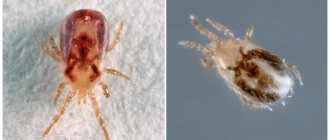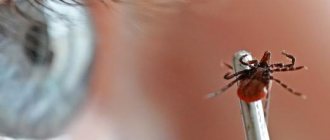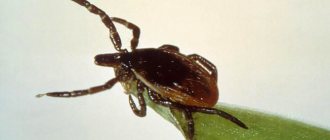Etiology
The causative agent, Rickettsia sibirica, was discovered in 1938 by O.S. Korshunova. Like other pathogens of the group of spotted fevers, it parasitizes both in the cytoplasm and in the nucleus of the affected cells. Antigenically it differs from other rickettsiae in this group. Contains a toxic substance. Characterized by properties common to all rickettsiae. Able to persist for a long time in the external environment at low temperatures (up to 3 years). Keeps well when dried. The virulence of individual strains varies significantly.
Epidemiology
The disease is classified as a zoonotic disease with natural focality. Natural foci have been identified in the Primorsky, Khabarovsk and Krasnoyarsk territories, in a number of regions of Siberia (Novosibirsk, Chita, Irkutsk, etc.), as well as in Kazakhstan, Turkmenistan, Armenia, Mongolia. The reservoir of rickettsia in nature is about 30 species of various rodents (mice, hamsters, chipmunks, gophers, etc.). Transmission of infection from rodent to rodent is carried out by ixodid ticks (Dermacentor nuttalli, D. silvarum, etc.). The infestation of ticks in foci reaches 20% or more. The incidence in the tick habitat ranges from 71.3 to 317 per 100,000 population per year. The immune layer of the population in natural foci ranges from 30 to 70%. Rickettsia remain in ticks for a long time (up to 5 years); transovarial transmission of rickettsia occurs. Not only adult ticks, but also nymphs participate in the transmission of infection to humans. Rickettsia is transmitted from ticks to rodents through blood sucking.
A person becomes infected during his stay in the natural habitats of ticks (shrubs, meadows, etc.), when he is attacked by infected ticks. The greatest activity of ticks is observed in spring and summer (May-June), which determines the seasonality of the incidence. The incidence is sporadic and occurs mainly among adults. Not only rural residents get sick, but also those traveling outside the city (garden plots, recreation, fishing, etc.). In recent years, about 1,500 tick-borne rickettsiosis diseases are registered annually in Russia.
North Asian tick-borne rickettsiosis
North Asian tick-borne rickettsiosis (synonyms: tick-borne rickettsiosis of North Asia, tick-borne typhus of North Asia, tick-borne typhus) is an acute infectious disease characterized by the presence of a primary affect, enlargement and pain of regional lymph nodes, and a widespread polymorphic rash.
Story. The disease was first identified in our country in 1934-1935 in the Far East by the Soviet military doctor E.I. Mill. In 1936-1937, it was described by N.I. Antonov and A.G. Neishtat under the name “Far Eastern tick-borne fever.” Twice, in 1938 and 1940, the disease was studied by an expedition led by M.K. Krontovskaya. The most complete clinical picture of North Asian tick-borne rickettsiosis was described by N.V. Sergeev (1940-1944), and then by S.M. Kulagin and G.I. Feoktistov. The name of the disease “tick-borne rickettsiosis” was given by M.K. Krontovskaya in 1940
Geographical distribution. North Asian tick-borne rickettsiosis has been registered in Western, Central and Eastern Siberia, Khabarovsk and Primorsky territories, some areas of Eastern and Northern Kazakhstan, in the Armenian SSR, Turkmen SSR and the Mongolian People's Republic.
Etiology. The causative agent of North Asian tick-borne rickettsiosis is Rickettsia sibirica Zdrodovskii et Golinevich, 1948; belongs to the Rickettsiaceae family. Rickettsia (see full body of knowledge) are localized in the cytoplasm and nucleus of cells. The exciter dimensions are 0.7–2.5 × 0.3 micrometers; it contains a highly active toxic substance. In nature, strains with reduced virulence are widespread, infection with which causes an asymptomatic infection.
Epidemiology. North Asian tick-borne rickettsiosis is a natural focal zoonosis (see full body of knowledge). The source of the infectious agent are small rodents - gophers, field and forest mice, house mice, hamsters, chipmunks, gray rats, pieds, Far Eastern and red-gray voles. The pathogen is transmitted by ixodid ticks of various species - Dermacentor nuttali, D. silvarum, D. marginatus and others, living in steppe and meadow bushes. A person becomes infected as a result of a tick attack in a natural focus of the disease (see full body of knowledge: Natural focality); Rickettsiae are transmitted by tick saliva. Sporadic incidence (0.29-1.8 per 100 thousand inhabitants) is recorded in the spring-summer period, which is associated with the activity of ixodid ticks at this time of year.
Pathogenesis and pathological anatomy. The determining factor in the pathogenesis of the disease is the vasodilating effect of rickettsia toxin and the parasitism of rickettsia in the vascular endothelium, which causes inflammatory changes in them; at the same time, proliferative processes prevail over destructive ones with the development of endoperivasculitis. The peculiarity of North Asian tick-borne rickettsiosis is that pathomorphological changes are most pronounced in the vessels of the skin, less so in the vessels of the brain and other organs.
Immunity after an illness is usually long-lasting, and recurrent illnesses are not observed.
Clinical picture. The incubation period ranges from 2 to 7, most often 3-6 days. Prodromal phenomena are observed within 1-3 days in the form of malaise, fatigue, vague muscle pain and chilling. Depending on the severity of symptoms, the disease can occur in mild, moderate or severe form.
The most common form is moderate. The disease usually begins acutely with a rise in temperature, the appearance of a headache, a feeling of heat with chills, sweating, pain throughout the body, including in joints and muscles, general weakness, sometimes inflammatory changes in the upper respiratory tract, sleep disturbances, and loss of appetite. These symptoms, gradually increasing, persist throughout the entire febrile period (see full body of knowledge: Fever). The temperature in the first two days reaches 39-40° and is often remitting; it usually decreases lytically. The duration of the febrile period is from 1 to 20 days, depending on the severity of the disease, usually 7-10 days. After several days of decreasing temperature, it may rise within two to five days, which is regarded as a consequence of difficult-to-diagnose pulmonary complications. The patient's face is often hyperemic and somewhat puffy already from the 2nd to 3rd day of illness.
Almost constantly, hyperemia of the mucous membrane of the soft palate, uvula and tonsils is detected, sometimes even with enanthema (see full body of knowledge: Rash) along the edges of the arches and at the base of the uvula.
The most constant and typical signs of the disease are primary affect (see full body of knowledge: Primary affect), which occurs at the site of a tick bite and is accompanied by regional lymphadenitis, which is detected on average in approximately 80% of patients. The primary affect is a dense painful infiltrate, covered with a brown necrotic crust and surrounded at the periphery by a pink border of hyperemia. A polymorphic, abundant roseolous-papular rash on the body appears on the 2-4th day of illness. The rash is most intense in the joint area. The rash is not accompanied by itching. In the first 1-2 days, roseola usually appears and, less often, papules appear. Later, roseolas turn into papules and very rarely into petechiae.
Disorders of the cardiovascular system are expressed in early-onset relative bradycardia, hypotension and decreased pulse pressure, and moderate interstitial myocarditis. Characteristic disorders of the central nervous system: Headache, usually diffuse, occurs in all patients, is intense in the first 5-6 days, and is often accompanied by insomnia or interrupted sleep. Sometimes meningism is detected (see full body of knowledge) with an increase in cytosis in the cerebrospinal fluid (see full body of knowledge) to 30-50 leukocytes per 1 microliter (mainly lymphocytes) and protein to 0.9 grams/liter. Catarrhal phenomena of the upper respiratory tract and bronchi are observed, but there are no changes in the lungs. Appetite decreases, nausea and vomiting, and diarrhea are possible. The tongue is moist, slightly coated with white coating. The abdomen is soft and very rarely painful (enlarged mesenteric nodes). In most patients, the liver and spleen are enlarged. The recovery period begins 9-11 days from the onset of the disease.
In a mild form, the febrile period lasts up to 7 days, the temperature does not exceed 38°, the condition of the patients is satisfactory, there is a moderate rash, mainly roseola, there are no complications.
The severe form, usually observed in older people, is characterized by fever lasting up to 20 days with a temperature of 39-41° and above; symptoms of damage to the central nervous system and cardiovascular system are expressed, an abundant papular rash with a tendency to hemorrhagic transformation of elements.
Sometimes an atypical course of the disease is observed - without primary affect, regional lymphadenitis or rash; perhaps an erased course, when the clinical picture is not sufficiently expressed.
Complications are rare; sinusitis, otitis media, laryngitis, bronchitis, and pneumonia occur.
The diagnosis is based on epidemiological history data (the presence of the patient in the outbreak of North Asian tick-borne rickettsiosis, tick bites, seasonality, short incubation period after a tick bite) and on the clinical picture. The blood shows normocytosis and moderate leukopenia with eosinopenia, neutropenia and relative lymphocytosis. To confirm the diagnosis, RSC and indirect hemagglutination test (IHA) are used, which become positive from the 5-7th day of illness, less often from the 9-11th day; RSK titers are low - 1: 40-1 - 160, RNGA - 1: 800-1: 3200; RSC remains positive for a long time.
Differential diagnosis is carried out with other rickettsial diseases (see full body of knowledge), typhoid fever (see full body of knowledge) and paratyphoid fever (see full body of knowledge), encephalitis (see full body of knowledge), hemorrhagic nephrosonephritis (see full body of knowledge).
Treatment is carried out with tetracycline preparations.
The prognosis is favorable even with severe disease.
Prevention. The main measure is the individual protection of people from tick attacks: when working in the territory of natural foci of North Asian tick-borne rickettsiosis, protective clothing is used (see full body of knowledge: Tick-borne encephalitis) and Pavlovsky repellent nets impregnated with repellents (see full body of knowledge: Protective nets); self and mutual examination of the body and clothing after each visit to tick habitats, removal of attached ticks, wiping the bite site with alcohol or iodine solution.
Specific prevention has not been developed.
| Loban K.M. |
⇐ Go to the main page of the site ⇐ | ⇑ Return to top of page ⇑ | Ordo Deus Library ⇒ ⇒ |
⇐ Seborrhea | ⇓ Complete body of knowledge. Volume one A. ⇓ |
Pathogenesis
The portal of infection is the skin at the site of the tick bite (rarely, infection occurs when rickettsia is rubbed into the skin or conjunctiva). At the site of introduction, a primary affect is formed, then rickettsiae move along the lymphatic pathways, causing the development of lymphangitis and regional lymphadenitis. Lymphogenously, rickettsiae penetrate into the blood and then into the vascular endothelium, causing changes of the same nature as in epidemic typhus, although they are much less pronounced. In particular, there is no necrosis of the vascular wall, thrombosis and thrombohemorrhagic syndrome rarely occur.
Endoperivasculitis and specific granulomas are most pronounced in the skin and to a much lesser extent in the brain. Allergic restructuring is more pronounced than in epidemic typhus. The transferred disease leaves a strong immunity, recurrent diseases are not observed.
Symptoms and course
The incubation period ranges from 3 to 7 days, rarely up to 10 days. There are no prodromal phenomena (with the exception of the primary affect, which develops soon after a tick bite). As a rule, the disease begins acutely, with chills, body temperature rises, general weakness, severe headache, pain in muscles and joints appear, sleep and appetite are disturbed. Body temperature in the first 2 days of illness reaches a maximum (39-40°C) and then persists as a fever of a constant type (rarely remitting). The duration of fever (without antibiotic treatment) most often ranges from 7 to 12 days, although in some patients it lasts up to 2-3 weeks. When examining the patient, mild hyperemia and puffiness of the face are noted. Some patients experience hyperemia of the mucous membrane of the soft palate, uvula, and tonsils. The most typical manifestations are primary affect and exanthema. When bitten by uninfected ticks, the primary affect never develops; its presence indicates the onset of the infectious process.
The primary affect is an area of infiltrated moderately compacted skin, in the center of which necrosis or a small ulcer covered with a dark brown crust is visible. The primary affect rises above the skin level, the zone of hyperemia around the necrotic area or ulcer reaches up to 2-3 cm in diameter, but there are changes of only 2-3 mm in diameter, and they are quite difficult to detect.
Not all patients note the very fact of a tick bite. Healing of the primary affect occurs after 10-20 days. In its place there may be pigmentation or peeling of the skin. A characteristic manifestation of the disease is exanthema, which is observed in almost all patients. It usually appears on days 3-5, rarely on days 2 or 6 of illness. First it appears on the limbs, then on the torso, face, neck, and buttocks. The rash is rarely observed on the feet and palms. The rash is abundant, polymorphic, consists of roseola, papules and spots (up to 10 mm in diameter).
Hemorrhagic transformation of rash elements and the appearance of petechiae are rarely observed. Sometimes there is a “sprinkling” of new elements. The rash gradually disappears by 12-14 days from the onset of the disease. There may be peeling of the skin at the site of the spots.
In the presence of primary affect, it is usually possible to detect regional lymphadenitis. Lymph nodes are enlarged to 2-2.5 cm in diameter, painful on palpation, not fused to the skin and surrounding tissues, suppuration of the lymph nodes is not observed.
From the cardiovascular system, bradycardia is noted, a decrease in blood pressure, arrhythmias and changes in the heart muscle according to ECG data are rare. Changes in the central nervous system are observed in many patients, but do not reach the same extent as occurs with epidemic typhus.
Patients are bothered by severe headaches, insomnia, patients are inhibited, agitation is observed rarely and only in the initial period of the disease. Mildly expressed meningeal symptoms are very rarely detected (in 3-5% of patients); when examining cerebrospinal fluid, cytosis usually does not exceed 30-50 cells in 1 μl. There are no pronounced changes in the respiratory system. Enlargement of the liver is observed in half of the patients, the spleen increases less frequently (in 25% of patients), the increase is moderate. The course of the disease is benign. After the temperature drops to normal, the patients' condition quickly improves and recovery occurs quickly. Complications, as a rule, are not observed. Even before the use of antibiotics, the mortality rate did not exceed 0.5%.
Rickettsial disease
Rickettsial diseases of the typhus group
Epidemic (lousy) typhus occurs with fever, intoxication, roseola-petechial rash on the skin, damage to the vascular and nervous systems.
The incubation period ranges from 5 to 21 days. Rickettsiosis manifests itself with an increase in body temperature and general intoxication symptoms, which reach maximum severity by the 3-6th day of the disease. During this period, marked hyperemia and puffiness of the face, injection of the sclera, and enanthema on the soft palate are noted. Approximately on the 5th day, a bright, characteristic roseola-petechial rash appears on the skin of the lateral surface of the chest, abdomen, and flexor surfaces of the arms. After a week, the rash turns pale, and disappears in the 2-3rd week from the onset of the disease. At the same time, the temperature decreases and intoxication disappears, but post-infectious asthenia persists for several more weeks. In severe cases of rickettsiosis, damage to the central nervous system occurs in the form of meningitis or encephalitis. Complications of epidemic typhus may include otitis media, mumps, pneumonia, and myocarditis. Brill's disease, or relapsing typhus, manifests itself with the same symptoms, but less pronounced. Endemic (rat or flea) typhus begins acutely and in the initial period is characterized by general infectious symptoms (fever, chills, arthralgia, headache). At the height of the febrile period, a rash appears on the chest, abdomen and limbs, which is predominantly roseolous-papular in nature. Characterized by arterial hypotension, bradycardia, general weakness, dizziness. In general, the disease is milder than epidemic typhus.
Rickettsial diseases of the spotted tick fever group
North Asian tick-borne rickettsiosis, or tick-borne typhus of North Asia, is transmitted through the bites of ixodid ticks. A typical sign of tick-borne rickettsiosis is the primary affect - the primary inflammatory reaction of the skin at the site of penetration of the pathogen. It is a painful compaction, surrounded by a zone of hyperemia and covered with a brown scab in the center. Simultaneously with the appearance of the primary affect, body temperature rises, regional lymphadenitis and intoxication syndrome develop. Skin rashes appear on the 2-3rd day and are represented by polymorphic roseolous-papular elements located on the body and around the joints. There is hyperemia of the face and pharynx mucosa, bradycardia, hypotension, and moderate hepatosplenomegaly. The course of North Asian tick-borne rickettsiosis is benign; usually by the 14th day of the disease recovery occurs.
Marseilles fever is also characterized by the presence of a primary affect at the site of tick penetration, fever, lymphadenitis, and maculopapular rash. The initial signs of rickettsiosis are similar to tick-borne typhus in North Asia. The primary affect looks like a dense infiltrate with central necrosis, which subsequently ulcerates and epithelializes only during the period of convalescence (after 3-4 weeks). Against the background of febrile intoxication manifestations, hyperemia of the oropharyngeal mucosa, sore throat, and conjunctivitis are expressed. The hallmark of Marseilles fever is a rash that affects not only the body, but also the face, palms and soles. Usually the rash is maculopapular in nature, but can transform into pimples (“pimply fever”) with hemorrhagic contents. The rash fades gradually, and pigmentation remains in its place for a long time.
Rocky Mountain spotted fever is a severe rickettsial disease. In the acute period, the disease is accompanied by chills followed by fever; severe headache and muscle pain, nosebleeds. Neurological changes include insomnia, impaired consciousness (stupefaction, prostration), convulsions, para- and hemiplegia, visual and hearing impairment. There is no primary affect. The rash with this type of rickettsiosis is profuse, petechial, and tends to merge to form large spots. The mortality rate from this rickettsiosis reaches 7%.
Paroxysmal rickettsial diseases
Paroxysmal rickettsiosis occurs with recurrent febrile attacks, repeating every 5 days (with Volyn fever) or 2-3 days (with paroxysmal tick-borne rickettsiosis). During an attack, the temperature rises to 39.0–40.5°C, chills, ossalgia, myalgia, arthralgia, and headaches appear. Primary affect, skin rashes and regional lymphadenitis are not constant companions of paroxysmal rickettsial infections and are often absent. The course of fevers is usually protracted, but benign.
Diagnosis and differential diagnosis
Epidemiological prerequisites (stay in endemic foci, seasonality, tick bites, etc.) and characteristic clinical symptoms in most cases make it possible to diagnose the disease. Primary affect, regional lymphadenitis, profuse polymorphic rash, moderate fever and benign course are of greatest diagnostic importance.
It is necessary to differentiate from tick-borne encephalitis, hemorrhagic fever with renal syndrome, typhoid and typhus, tsutsugamushi fever, syphilis. Sometimes in the first days of the illness (before the appearance of the rash), an erroneous diagnosis of influenza is made (acute onset, fever, headache, facial flushing), but the absence of inflammatory changes in the upper respiratory tract and the appearance of a rash make it possible to refuse the diagnosis of influenza or acute respiratory infections.
Epidemic typhus and tsutsugamushi fever are much more severe with pronounced changes in the central nervous system, with hemorrhagic transformation of the elements of the rash, which is not typical for tick-borne typhus in North Asia. With syphilis, there is no fever (sometimes there may be a low-grade temperature), signs of general intoxication, a profuse, polymorphic rash (roseola, papules), which persists for a long time without much dynamics. Hemorrhagic fever with renal syndrome is characterized by severe kidney damage, abdominal pain, and a hemorrhagic rash.
To confirm the diagnosis, specific serological reactions are used: RSK and RNGA with diagnosticums from rickettsia. Complement-fixing antibodies appear from 5-10 days of illness, usually in titers of 1:40-1:80 and subsequently increase. After the illness, they persist for up to 1-3 years (in titers 1:10-1:20). In recent years, the indirect immunofluorescence reaction has been considered the most informative.
Symptoms of the disease
The incubation period of tick-borne rickettsiosis can range from 2 to 7 days. The disease almost always develops acutely. At the site of the tick bite, pain and redness appear, in the center of which a small infiltrate with a necrotic crust is visible. Almost simultaneously with this, the following symptoms appear, expressing primary affect:
- chills;
- body aches;
- swollen lymph nodes;
- increase in body temperature up to 40 degrees;
- feverish condition;
- Strong headache;
- weakness.
2-3 days after the onset of the disease, the following initial symptoms are added to the listed initial symptoms:
profuse rash covering the palms, soles, face, torso;
- nausea;
- vomit;
- abdominal pain;
- lack of appetite;
- a sharp decrease in body weight;
- decrease in hemoglobin by 15%, decrease in the number of red blood cells and platelets;
- lesions of the cardiovascular system associated with low blood pressure, bradycardia, vasculitis;
- lesions of the nervous system, manifested by arthralgia, myalgia.
This disease is characterized by cyclicity.
The primary affect begins to reverse its development approximately from 9-12 days from the onset of the illness: the temperature decreases, the rash disappears, and the lymph nodes return to normal.
In children, the disease occurs in a more acute form, but is relatively milder than in adults. Tick-borne rickettsiosis is especially difficult for older people.
According to the severity of the disease, there are: severe, moderate and mild forms. The severe form is characterized by a longer febrile period, significant intoxication of the body, temperature values reaching 41 degrees, more pronounced symptoms from the cardiovascular and nervous system, there may be complications in the form of neuritis, myocarditis, bronchitis, pyelonephritis, etc.
The general clinical picture of tick-borne rickettsiosis, due to the variety of its forms, may differ in both the course of the disease and symptoms. Correct diagnosis of the disease is very important to prescribe effective treatment.









